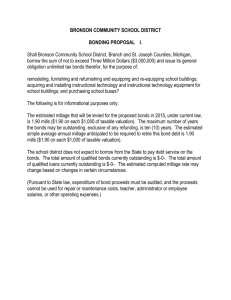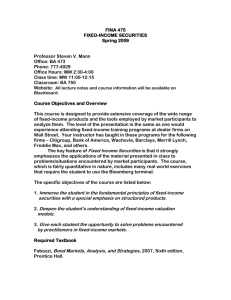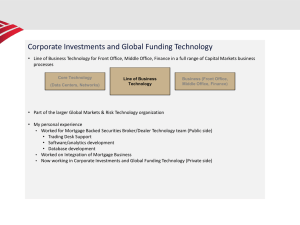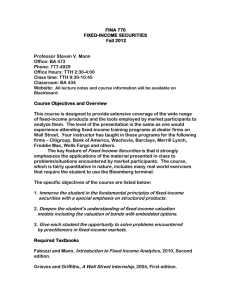FNA3102 Investment Analysis - NUS Business School
advertisement
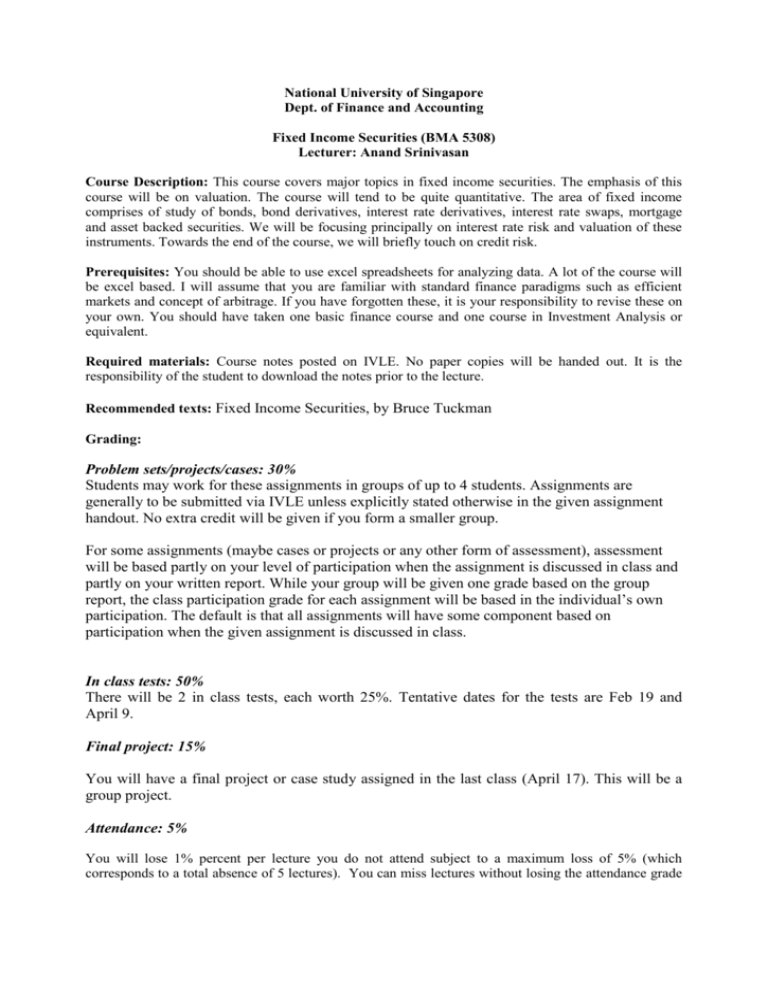
National University of Singapore Dept. of Finance and Accounting Fixed Income Securities (BMA 5308) Lecturer: Anand Srinivasan Course Description: This course covers major topics in fixed income securities. The emphasis of this course will be on valuation. The course will tend to be quite quantitative. The area of fixed income comprises of study of bonds, bond derivatives, interest rate derivatives, interest rate swaps, mortgage and asset backed securities. We will be focusing principally on interest rate risk and valuation of these instruments. Towards the end of the course, we will briefly touch on credit risk. Prerequisites: You should be able to use excel spreadsheets for analyzing data. A lot of the course will be excel based. I will assume that you are familiar with standard finance paradigms such as efficient markets and concept of arbitrage. If you have forgotten these, it is your responsibility to revise these on your own. You should have taken one basic finance course and one course in Investment Analysis or equivalent. Required materials: Course notes posted on IVLE. No paper copies will be handed out. It is the responsibility of the student to download the notes prior to the lecture. Recommended texts: Fixed Income Securities, by Bruce Tuckman Grading: Problem sets/projects/cases: 30% Students may work for these assignments in groups of up to 4 students. Assignments are generally to be submitted via IVLE unless explicitly stated otherwise in the given assignment handout. No extra credit will be given if you form a smaller group. For some assignments (maybe cases or projects or any other form of assessment), assessment will be based partly on your level of participation when the assignment is discussed in class and partly on your written report. While your group will be given one grade based on the group report, the class participation grade for each assignment will be based in the individual’s own participation. The default is that all assignments will have some component based on participation when the given assignment is discussed in class. In class tests: 50% There will be 2 in class tests, each worth 25%. Tentative dates for the tests are Feb 19 and April 9. Final project: 15% You will have a final project or case study assigned in the last class (April 17). This will be a group project. Attendance: 5% You will lose 1% percent per lecture you do not attend subject to a maximum loss of 5% (which corresponds to a total absence of 5 lectures). You can miss lectures without losing the attendance grade for the following reasons. For each reason, the accompanying documentation that will be required in order for you to get credit for the missed class or classes is also mentioned. 1. Sickness or injury: A certificate given by a medical practitioner that clearly states the time period for which absence is necessary. This to be provided within 1 week of last missed lecture. 2. Family bereavement: Letter from parent/guardian stating the nature of the bereavement with their contact details; instructor to be notified within two weeks of last missed lecture. 3. Job interview: Letter/e-mail from interviewer confirming venue, date and time; instructor to be notified in advance of the interview. If you miss 6 or more lectures without appropriate reasons as stated above, I may fail you in the course independent of your performance in other components of the assessment. Late submission of problem set/project/case and missed in-class test policy: Late submissions of assignments or late/early test taking will not be accepted except when the late submission or late/early test taking is due to any one of the three mitigating circumstances as given above in the attendance section. In case the solution to the given test or homework has been discussed in class, instructor will provide either provide a make up test or assignment or add the credit to another component of the grade depending on the particular situation. Policy for group work All members in a group will get the same grade for the given case or assignment. You can have different group members for different assignments or cases and you can freely change group members. I will not adjudicate on any disputes within groups. Consultation Hours: By prior appointment only. Course Contents (tentative list – subject to change) 1. Overview Features of bonds Risks associated with bonds US treasury bonds and Auctions Agency bonds Corporate Debt Municipal Bonds Stripped Bonds Mortgage backed securities Floating Rate Securities Interest Rate Swaps Futures Options 2. Zeros and Coupon Bonds Framework for pricing Quotation conventions Accrued Interest conventions Zero Discount factors Synthesizing of zeros from coupon bonds 1 Synthesizing of coupon bonds from zeros Relation between discount factor and semi-annual rate Valuation of a stream of cash flows in terms of zero rates 3. Case 1 – Hutchison Whampoa Yankee Bond offering 4. Spot rates and forward rates Definition of spot rate and forward rate Calculation of synthetic forward rate Calculation of forward price Spot rates as an average of forward rates Forward rates versus future spot rates 5. Yield of a bond Yield measures – Current Yield, Yield to maturity, yield to call, yield to put, yield to worst Price-yield formula for bond on coupon date Definition of term structure Illustration of Pull to Par effect Illustration of the Coupon effect Differences between yield and rate of return Definition of par rate Extracting yield curves in practice Singapore Government Yield curve Going from the yield curve to the par rate curve Going from the yield curve to the forward rate curve Problems with linear interpolation of yield curves 6. Interest rate risk – Duration Price rate function of a zero Meaning of a change in the interest rate Dollar Value of a basis point Special cases of DV01 for zeros, coupon bonds, consols Dollar duration Dollar duration of a portfolio Duration Modified duration Duration of a portfolio Modified duration of a portfolio 7. Interest rate risk - Convexity Convexity correction as the second order derivative Dollar convexity of a portfolio Convexity of a portfolio Barbells and Bullets 8. Immunization Hedging Interest rate risk Dedication Immunization by duration matching Immunization by duration and convexity matching Immunization by key rate hedging 9. Excel project on immunization using all methods 2 10. Floating rate bonds & Swaps Floaters and Inverse floaters Valuation Interest Rate sensitivity Interest Rate Swaps Uses Valuation Interest rate sensitivity Swap spread Credit risk in swaps 11. No arbitrage pricing Introduction to the binomial model State contingent prices Risk Neutral probabilities Relation between true probabilities and risk-neutral probabilities No arbitrage in a multi-period setting Dynamic replication Pricing of bond options using dynamic replication 12. Modeling of interest rates Constructing an interest rate tree based on observed prices Equilibrium modeling of interest rates Effects of expectation and uncertainty Convexity effect Risk premium Continuous time versus discrete time Models of interest rates Normal Normal with drift Lognormal Ho and Lee model Original Salomon Brothers model Hedging of interest rates Hedge ratios Interest rate delta Option delta 13. Case 2- Deutsche Bank: Finding relative value trades 14. European and American Options Black model Valuation of an American Call Optimal Exercise policy 15. Callable bond valuation 16. Swaptions Receiver swaption Payer swaptions Cancelable swaps 17. Mortgages Types of mortgages Calculation of monthly interest payments 3 Valuation of non-prepayable mortgage Valuation of prepayable mortgage Deterministic prepayment Optimal prepayment Path-dependent prepayment Valuation of Mortgage backed securities Interest only Principal only Collateralized mortgage obligations Planned amortization class bonds 18. Convertible bond valuation 19. Case 3 – Advanced Material Technology Corporation 20. Caps and floors Valuation Interest rate risk Capped floater Caps and inverse floaters Interest rate collars 21. Miscellaneous (not to be covered in detail) Repos Altman model Merton model Credit default swaps 22. Final case or project 4


